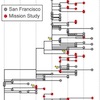 Community Transmission of Severe Acute Respiratory Syndrome Coronavirus 2 Disproportionately Affects the Latinx Population During Shelter-in-Place in San Francisco
Community Transmission of Severe Acute Respiratory Syndrome Coronavirus 2 Disproportionately Affects the Latinx Population During Shelter-in-Place in San FranciscoGabriel Chamie, Carina Marquez, Emily Crawford, James Peng, Maya Petersen, Daniel Schwab, Joshua Schwab, Jackie Martinez, Diane Jon Es, Douglas Black, Monica Gandhi, Andrew D Kerkhoff, Vivek Jain, Francesco Sergi, Jon Jacobo, Susana Rojas, Valerie Tulier-Laiwa, Tracy Gallardo-Brown, Ayesha Appa, Charles Chiu, Mary Rodgers, John Hackett, Amy Kistler, Samantha Hao, Jack Kamm, David Dynerman, Joshua Batson, Bryan Greenhouse, Joe DeRisi, Diane V Havlir, CLIAhub Consortium
Infectious Disease Society of America, 2020Abstract: Background: There is urgent need to understand the dynamics and risk factors driving ongoing SARS-CoV-2 transmission during shelter-in-place mandates.
Methods: We offered SARS-CoV-2 reverse transcription-PCR and antibody (Abbott ARCHITECT IgG) testing, regardless of symptoms, to all residents (≥4 years) and workers in a San Francisco census tract (population: 5,174) at outdoor, community-mobilized events over four days. We estimated SARS-CoV-2 point prevalence (PCR-positive) and cumulative incidence (antibody or PCR-positive) in the census tract and evaluated risk factors for recent (PCR-positive/antibody-negative) versus prior infection (antibody-positive/PCR-negative). SARS-CoV-2 genome recovery and phylogenetics were used to measure viral strain diversity, establish viral lineages present, and estimate number of introductions.
